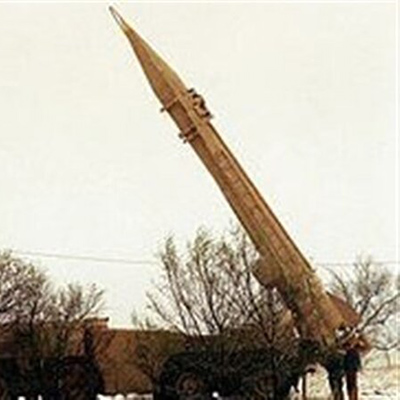Terms & Concepts
The Missile War
Written by: Mohsen Shirmuhammad,
Translated by: Hadi Qorbanyar
21 دورہ
During the eight years of the Iran–Iraq War, both sides used missiles to attack each other’s territory. However, Iran’s use of missiles was far more limited compared to the Baathist regime of Iraq.
From the very beginning of its full-scale invasion on September 22, 1980, Iraq started targeting Iranian civilian and residential areas, particularly Dezful, with surface-to-surface missiles. The first missile attack on Dezful took place at midnight on Wednesday, October 8, 1980, when Iraq fired four FROG missiles at residential neighborhoods. The attack destroyed about 500 houses and shops, leaving 350 people martyred or injured. Thirty of the wounded were infants under six months old. Over the course of the war, Iraq fired 122 FROG missiles at Dezful.[1]
The Soviet-made FROG missile, also known as the Luna, measured 9 meters in length, carried a 455-kilogram warhead,[2] and had a maximum range of 65 kilometers. Nonetheless, due to its poor accuracy, the missile was typically used to target cities and population centers, where it was more likely to cause damage.[3]
On October 26, 1982, Iraq also fired its first Scud missile at Iran, again targeting Dezful.[4] The Scud-B missile was 11.25 meters long, weighed 6,300 kilograms, and had a range of 290–300 kilometers.[5] At the beginning of the war, Iraq possessed 8 Scud launchers[6] and 26 FROG launchers.[7] In total, 174 Iraqi missiles were launched against Dezful over the course of the war. [8]
Andimeshk was also repeatedly targeted by Iraqi missiles. During the war, Iraq fired 84 missiles at the city. Out of 1,000 martyrs of Andimeshk, 550 were civilians who lost their lives in missile strikes on residential areas.[9]
After the outbreak of the war, the conflict escalated in four distinct phases, each marked by widespread aerial bombardment and missile strikes targeting cities and civilian centers. The first phase began on March 4, 1985, when 39 Iranian cities and villages came under Iraqi missile attacks which caused the martyrdom of 1,227 people and injuries to 4,682.[10]
Until late 1984, Iran did not possess any surface-to-surface missiles.[11] With Iraq’s continued attacks on Iranian cities, Iranian authorities decided to purchase missiles. Subsequently, Iran received a single Scud-B launcher along with 30 Scud-B missiles from Libya.[12]
The first shipment, consisting of 10 Scud-B missiles, arrived in Iran on November 26, 1984. Along with the transferred missile site, several Libyan missile specialists also came to Iran. Due to the Soviet Union’s refusal, Syria did not sell missiles to Iran but agreed to train Iranian forces in operating Scud-B missiles.[13]
The second round of missile and aerial attacks targeting cities began on May 26, 1985, and lasted for 20 days, leaving 570 martyred and 1,332 injured in Iran. During 115 missile, air, and artillery attacks, 27 Iranian cities were struck by Iraq.
The third phase began on February 19, 1987, and continued for 42 days. In addition to aerial and artillery bombardments, 27 missile strikes were carried out. These attacks started with attacking residential areas of Susangerd, and ultimately 65 Iranian cities were hit, leaving 3,035 martyred and 11,150 injured.[14]
By early 1987, Libya, in support of Iraq, stopped supplying missiles to Iran. The Libyan military advisers in Iran also secretly dismantled some remaining missile parts and launch platforms and took them back to their country. From that point on, Scud missile launches were handled by the Islamic Revolutionary Guard Corps (IRGC) personnel.[15] Later in the war, Iran purchased 30 Scud-B missiles from North Korea.[16]
From 1986, Iran also began launching Oqab missiles. Based on the Chinese “Model-82” and produced by Defense Industries Organization,[17] the Oqab carried a 70-kilogram warhead, measured 4.82 meters in length, and had a range of 40 kilometers.[18] It lacked accuracy and was only suitable for striking large targets. Iran could use this missile to hit Iraqi cities near the border, such as Basra.[19]
The fourth round of large-scale Iraqi missile and air attacks on Iranian cities, towns, and other population centers—and Iran’s retaliatory strikes on Iraq’s military, industrial, and economic facilities—began on February 27, 1988, with an Iraqi attack on the Tehran refinery and subsequently the city on February 29. This phase lasted until late April 1988, a total of 53 days. For the first time, Tehran and the cities of Qom, Isfahan, Tabriz, Karaj, and Shiraz were struck by Iraqi missiles.[20]
Many of the missiles launched at Tehran exploded in mid-air or failed to detonate.[21] The premature explosions occurred because the missiles reentered the atmosphere at shallow angles, causing them to travel longer distances and generate excessive heat due to air friction.[22] They were the same Scud-B missiles, modified with lighter 160-kilogram warheads and expanded fuel capacity,[23] extending their range to 500 kilometers. Iraq renamed them al-Husayn.[24] The first strikes on Tehran, Isfahan, and Qom caused public protests in Iran against the Soviet Union. A group of people and university students gathered outside the Soviet embassy and consulate in Tehran and Isfahan, protesting Moscow’s policy towards the war. In response, some Soviet officials denied supplying Iraq with more powerful missiles.[25] The Soviets claimed that the Scud-Bs they had sold to Iraq did not have the range to reach Tehran,[26] while Iran asserted that recovered missile fragments proved they were Soviet-made and manufactured in 1985 and 1986. These missiles were likely part of a shipment of 300 Scud-Bs delivered by the USSR to Iraq in 1986.[27] Some experts believed that Iraq, with East German technical assistance, had successfully extended the range of the Scud-B.[28]
During this period, Iraq launched a total of 189 missiles: 134 targeted Tehran, 23 hit Isfahan, 17 struck Qom, 8 were fired at Tabriz, 4 at Karaj, and 3 at Shiraz. These attacks resulted in the martyrdom of at least 1,746 and injuries to 8,183, and extensive damage.[29] In retaliation, Iran launched 50 missiles[30] at Baghdad and Mosul.[31] Iran’s retaliatory strikes were limited to Iraqi military, political, and industrial targets and, by Imam Khomeini’s directive, were carried out with prior warning.[32]
Iran also began using a domestically produced missile known as the Iran-130, developed by the Defense Industries Organization,[33] though it was never mass-produced.[34] This missile had a range of 90 kilometers.[35] The first Iran-130 was launched by the IRGC on March 19, 1988, against the city of Amarah.[36]
In total, during the eight-year war, Iraq fired 153 al-Husayn missiles, 175 Scuds, and 82 FROG missiles,[37] while Iran fired 326 Oqab missiles, 11 Iran-130s, and 119 Scuds at Iraqi territory.[38]
[1] Alaei, Hussain, Ravad-e Jang-e Iran va Araq (The Course of the Iran–Iraq War), Vol. 1, Tehran, Marz va Boom, 1391, p. 228.
[2] Cordesman, Anthony & Abraham Wagner, Dars-haye Jang-e Modern, Jang-e Iran va Araq (Lessons of Modern Warfare: The Iran–Iraq War), Vol. 2, trans. Hussain Yekta, Tehran, Marz o Boom, 1390, Pp. 444–445.
[3] Alaei, Ibid., p. 228.
[4] Salemi-Nejad, Abdolreza, Dezful; Gozareshi az Shahr-e Moqavem-e Dezful dar Jang-e Shahrha 1359–1367 (Dezful; A Report on the Resilient City of Dezful during the City Bombardment War 1980–1988), Tehran, Markaz-e Asnad va Tahqiqat-e Defa Muqaddas, 1397, p. 155.
[5] Cordesman, Anthony & Abraham Wagner, Ibid., p. 446.
[6] Cordesman, Anthony & Abraham Wagner, Dars-haye Jang-e Modern, Jang-e Iran va Araq (Lessons of Modern Warfare: The Iran–Iraq War), Vol. 1, trans. Hussain Yekta, Tehran, Marz o Boom, 1389, p. 365.
[7] Ibid., p. 157.
[8] Alaei, Hussain, Ibid., p. 228.
[9] Ibid., p. 229.
[10] Izadi, Yadollah, Dour-e Chaharom-e Jang-e Shahrha Alayh-e Iran 8/12/1366 ta 31/1/1367 (The Fourth Round of Targeting Iranian Cities, February 27, 1988 – Apr 20, 1988), Faslname-ye Negin-e Iran, No. 45, Tabestan 1392, p. 79.
[11] Cordesman, Anthony & Abraham Wagner, Dars-haye Jang-e Modern, Jang-e Iran va Araq (Lessons of Modern Warfare: The Iran–Iraq War), Vol. 2, p. 444.
[12] Alaei, Hussain, Ravad-e Jang-e Iran va Araq (The Course of the Iran–Iraq War), Vol. 2, Tehran, Marz va Boom, 1391, p. 82.
[13] Ibid., p. 83.
[14] Izadi, Yadollah, Ibid., p. 79.
[15] Sefr ta Sad-e Tarikhche-ye Moshak-haye Irani (A Complete Historical Overview of Iranian Missiles), Jam-e Jam Online, 17 Shahrivar 1398, www.jamejamonline.ir/fa/news/1227334/
[16] Alaei, Hussain, Ravad-e Jang-e Iran va Araq (The Course of the Iran–Iraq War), Vol. 2, p. 83.
[17] Asadi, Heybatollah, Atash-e Topkhaneh (Artillery Fire), Tehran, Entesharat Dafos AJA, 1394, p. 397.
[18] Cordesman, Anthony & Abraham Wagner, Dars-haye Jang-e Modern, Jang-e Iran va Araq (Lessons of Modern Warfare: The Iran–Iraq War), Vol. 1, p. 445.
[19] Cordesman, Anthony & Abraham Wagner, Dars-haye Jang-e Modern, Jang-e Iran va Araq (Lessons of Modern Warfare: The Iran–Iraq War), Vol. 2, Pp. 206 & 486.
[20] Izadi, Yadollah, Ibid., p. 78.
[21] Alaei, Hussain, Ravad-e Jang-e Iran va Araq (The Course of the Iran-Iraq War), Vol. 2, p. 410.
[22] Ardestani, Hussain & Yadollah Izadi, Roozshomar-e Jang-e Iran va Araq, Ketab 53, Vol. 2, Moshakbaran-e Tehran (Chronology of the Iran–Iraq War, Book 53, Vol. 2, Missile Strikes on Tehran), Tehran, Markaz-e Asnad va Tahqiqat-e Defa Muqaddas, 1398, p. 429.
[23] Alaei, Hussain, Ravad-e Jang-e Iran va Araq (The Course of the Iran–Iraq War), Vol. 2, p. 410.
[24] Cordesman, Anthony & Abraham Wagner, Dars-haye Jang-e Modern, Jang-e Iran va Araq (Lessons of Modern Warfare: The Iran–Iraq War), Vol. 2, Pp. 201–202.
[25] Izadi, Yadollah, Ibid., p. 79.
[26] Cordesman, Anthony & Abraham Wagner, Dars-haye Jang-e Modern, Jang-e Iran va Araq (Lessons of Modern Warfare: The Iran–Iraq War), Vol. 2, p. 487.
[27] Ibid., p. 203.
[28] Ibid., p. 202.
[29] Izadi, Yadollah, Ibid., Pp. 79–80.
[30] Alaei, Hussain, Ravad-e Jang-e Iran va Araq (The Course of the Iran-Iraq War), Vol. 2, p. 425.
[31] 10 Esfand 1366 – Aghaz-e Hamle-ye Moshaki-ye Rezhim-e Baath Araq be Tehran, 11 Esfand 1401 (February 29, 1988 – Beginning of Baathist Iraq’s Missile Attacks on Tehran, March 2, 2023), Sait-e Moassese-ye Farhangi Honari-ye Payam-e Azadegan, www.mfpa.ir/fa/news/8254/10
[32] Bazkhani-e Tarikhi-ye Adam-e Estefade Iran az Selahe Koshtar-e Jami (Historical Review of Iran’s Non-Use of Weapons of Mass Destruction), https://farsi.khamenei.ir/28140; Chandin Nokte dar Bab-e Jang-e Shahrha (Reflections on the Targeting the Cities during the War ), ISNA, 14 Mehr 1401, www.isna.ir/news/1401071406692; Mosahebe ba Mohsen Rezaei (Interview with Mohsen Rezaei), Faslname-ye Negin-e Iran, No. 25, Tabestan 1387, Pp. 65–66.
[33] Iran-130 Avalin Moshak-e Zamin be Zamin-e Bomi-ye Keshvar (Iran-130, the First Domestic Surface-to-Surface Missile), Bashgah-e Khabarnegaran-e Javan, 24 Shahrivar 1393, 4977262, www.yjc.ir/fa/news/
[34] Cordesman, Anthony & Abraham Wagner, Dars-haye Jang-e Modern, Jang-e Iran va Araq (Lessons of Modern Warfare: The Iran–Iraq War), Vol. 2, p. 207.
[35] Asadi, Heybatollah, Ibid., p. 396.
[36] Cordesman, Anthony & Abraham Wagner, Dars-haye Jang-e Modern, Jang-e Iran va Araq (Lessons of Modern Warfare: The Iran–Iraq War), Vol. 2, p. 207.
[37] Asadi, Heybatollah, Ibid., p. 394.
[38] Ibid., p. 395.



